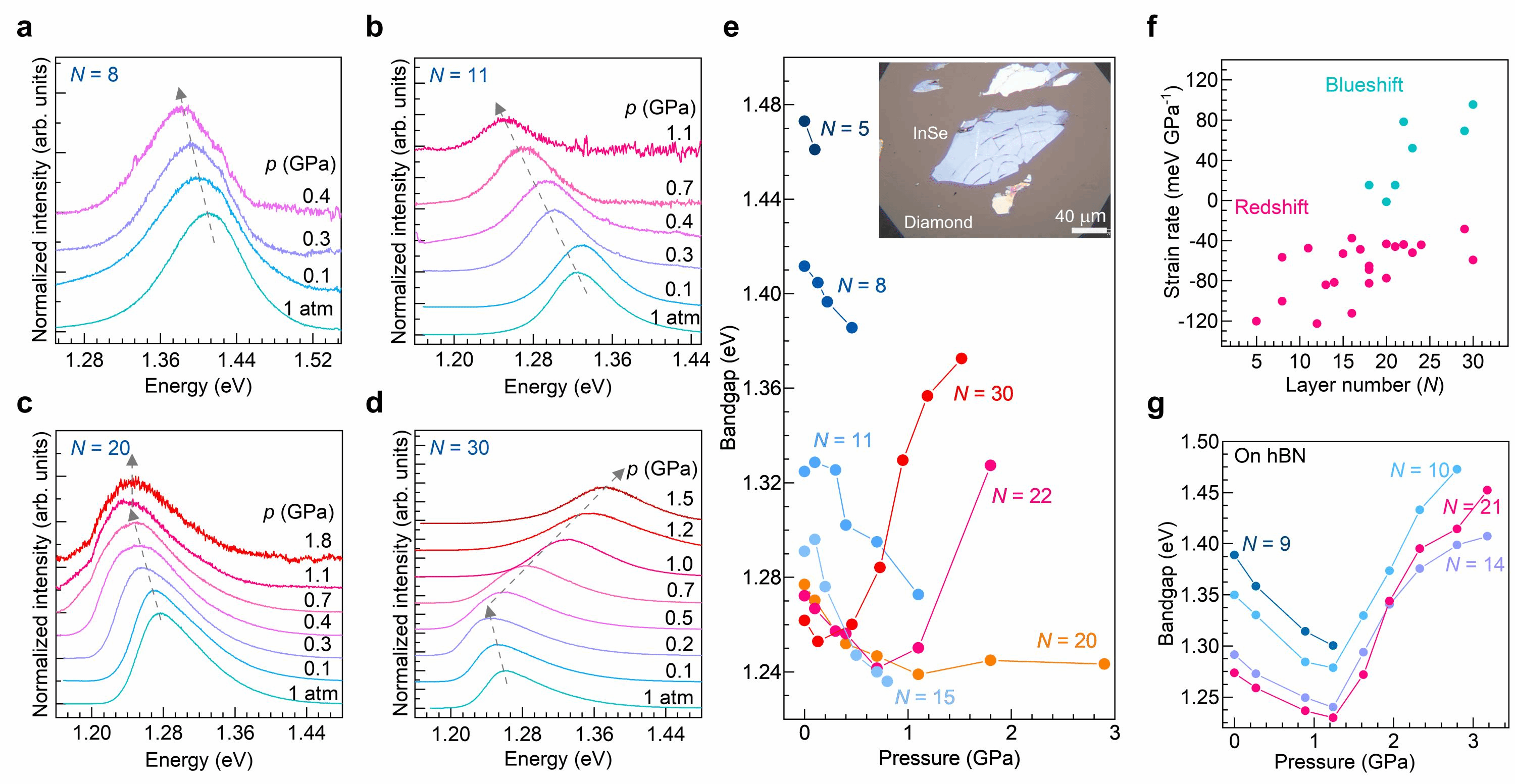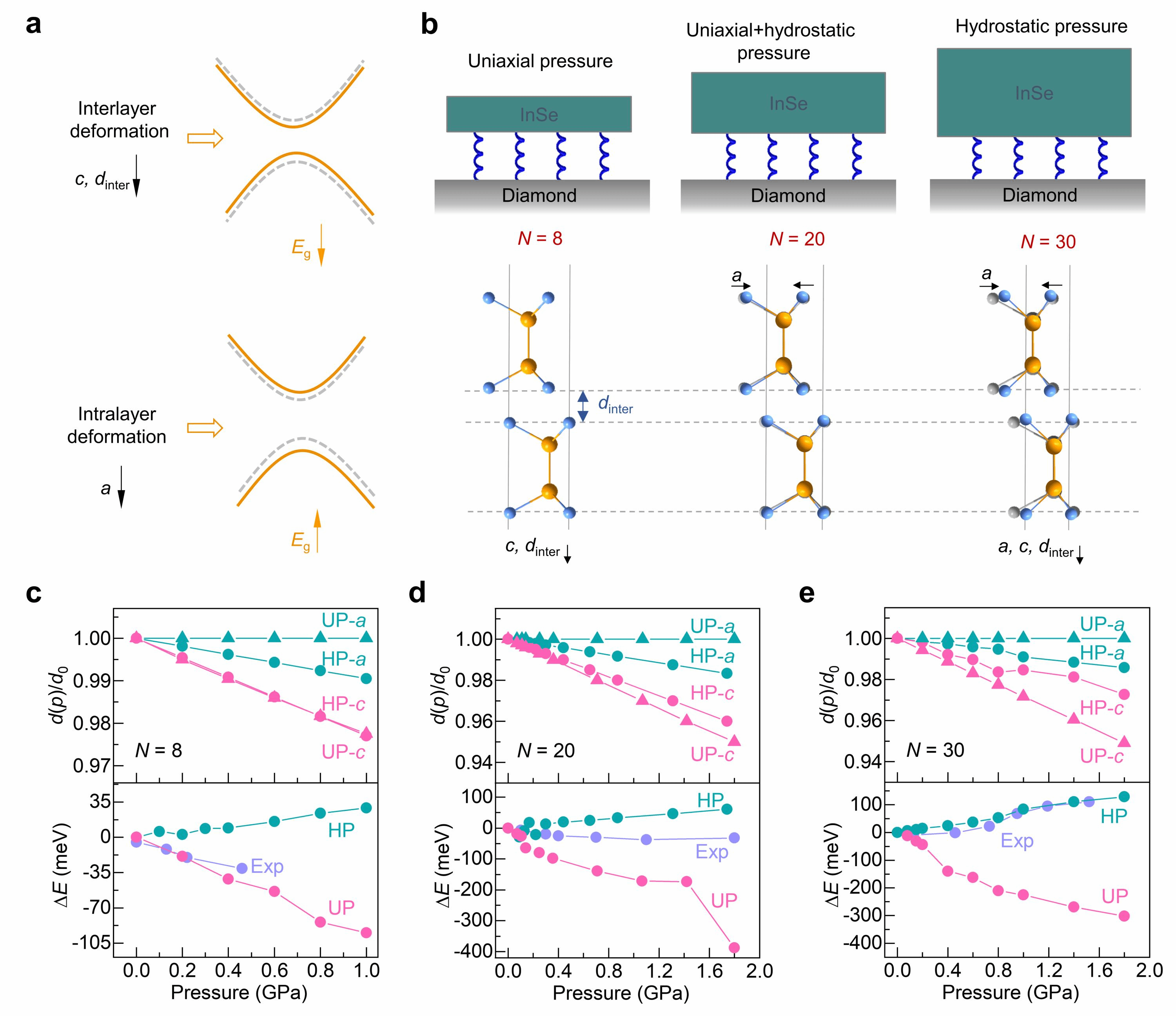The research team of Prof. Qing Zhang from the School of Materials Science and Engineering at Peking University, in collaboration with the team of Prof. Xiaoding Wei from the Department of Mechanics and Engineering Science, College of Engineering at Peking University, have revealed the lattice deformation mechanism with the layer thickness variation of two-dimensional (2D) indium selenide (InSe) semiconductor materials under hydrostatic pressure and gained a deep understanding of the optical transition evolution under high pressure control. These findings provide new ideas for the design of high-level optoelectronic devices. The research results, entitled "Probing Anisotropic Deformation and Near-Infrared Emission Tuning in Thin-Layered InSe Crystal under High Pressure," were published on April 6, 2023, in Nano Letters (DOI: 10.1021/acs.nanolett.3c00593).
2D layered semiconductor materials have simple and adjustable optical and electrical properties, making them potential materials for developing low-consumption integrated electronic and optoelectronic devices. Under external stress fields (such as pressure), these materials are prone to lattice distortion. Therefore, people can use strain engineering to widely control their key parameters such as carrier mobility, photoluminescence quantum yield, and Curie temperature, and induce novel physical properties such as topological phase transitions and superconductivity. InSe is a 2D semiconductor material with high electron mobility, visible to near-infrared broadband emission, and highly compressible, providing a good material platform for developing high-level light sources and optical sensors. Conducting high-pressure spectroscopic studies on InSe materials is crucial for understanding their structure-property relationship and exploring pressure-related novel properties.
This work investigates the lattice and electronic transition behavior of different-layered InSe thin films under hydrostatic pressure by placing them in a diamond anvil cell system (Figure 1). When the layer numberNis greater than 20, the emission peak of InSe exhibits a significant blueshift (approximately 128 meV under 1.5 GPa). However, whenNis less than 15, the emission peak shows a monotonic redshift (at a rate of about 100 meV GPa-1). In the InSe/hexagonal boron nitride system, the emission peak shift behavior of all thickness samples is consistent, indicating that the above layer-dependent behavior may originate from the interface interaction between InSe and diamond.

Figure 1: Pressure dependent of photoluminescence spectra for InSe flakes with different layer numberN
Combined with first-principles calculations, the study reveals the mechanism of lattice deformation and electronic bandgap evolution of InSe with layer thickness dependence under hydrostatic pressure (Figure 2): whenN= 5-15, due to the adhesion force between InSe and diamond being greater than the intralayer compression force, uniaxial strain is generated, and interlayer compression dominates, resulting in a decrease of the electronic bandgap; whenN= 15-20, as the number of layers increases, the intralayer compression force gradually counteracts the adhesion force, resulting in a pressure environment that has both uniaxial and hydrostatic pressure features; whenN= 20-30, the intralayer compression force completely surpasses the adhesion force, and hydrostatic pressure dominates, leading to an increase of the electronic bandgap.

Figure 2: Modal and theoretical calculations of layer dependent anisotropic deformation and bandgap evolution
The co-first authors of this work are Dr. Liyun Zhao from the School of Materials Science and Engineering (Current position: Qilu University of Technology (Shandong Academy of Sciences)) and Dr. Yingjie Jiang from the Department of Mechanics and Engineering Science, College of Engineering. The corresponding authors of this work are Prof. Qing Zhang, Prof. Xiaoding Wei, and Dr. Liyun Zhao. This work was also supported by the National Key Research and Development Program of China, the National Natural Science Foundation of China, the Natural Science Foundation of Beijing Municipality and the High-Pressure Station of Beijing Synchrotron Radiation Facility, Institute of High Energy Physics of the Chinese Academy of Sciences.
Publication link: https://pubs.acs.org/doi/10.1021/acs.nanolett.3c00593